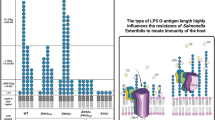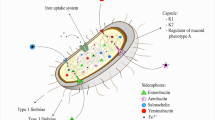Abstract
Streptococcus suis is a major bacterial pathogen of swine and an emerging zoonotic agent that has to date resulted in substantial economic losses to the swine industry worldwide, and can cause persistent infection by forming biofilms. GrpE and histidine protein kinase ComD are important proteins implicated in the pathogenicity of S. suis, although whether they play roles in adhesion and biofilm formation has yet to be sufficiently clarified. In this study, we constructed grpE and comD deletion strains of S. suis by homologous recombination, and examined their cell adhesion and biofilm formation capacities compared with those of the wild-type strain. The pathogenicity of the grpE and comD deletion strains was evaluated using a mouse infection model, which revealed that compared with the wild-type, these deletion strains induced milder symptoms and lower bacteremia, as well as comparatively minor organ (brain, spleen, liver, and lung) lesions, in the infected mice. Moreover, the deletion of grpE and comD significantly reduced the pro-inflammatory cytokine (IL-6, IL-1β, and TNF-α) induction capacity of S. suis. Collectively, the findings of this study indicate that the GrpE and ComD proteins of Streptococcus suis play key roles in the adherence to PK-15 cells and the formation of biofilms, thereby contributing to the virulence of this pathogen.







Similar content being viewed by others
References
Asempa TE, Motos A, Abdelraouf K, Bissantz C, Zampaloni C, Nicolau DP (2020) Meropenem-nacubactam activity against AmpC-overproducing and KPC-expressing Pseudomonas aeruginosa in a neutropenic murine lung infection model. Int J Antimicrob Agents 55:105838. https://doi.org/10.1016/j.ijantimicag.2019.10.019
Bracher A, Verghese J (2015) The nucleotide exchange factors of Hsp70 molecular chaperones. Front Mol Biosci 2:1–9. https://doi.org/10.3389/fmolb.2015.00010
Che RX, Xing XX, Liu X, Qu QW, Chen M, Yu F, Ma JX, Chen XR, Zhou YH, God’Spower BO et al (2019) Analysis of multidrug resistance in Streptococcus suis ATCC 700794 under tylosin stress. Virulence 10:58–67. https://doi.org/10.1080/21505594.2018.1557505
Fittipaldi N, Segura M, Grenier D, Gottschalk M (2012) Virulence factors involved in the pathogenesis of the infection caused by the swine pathogen and zoonotic agent Streptococcus suis. Future Microbiol 7:259–279. https://doi.org/10.2217/fmb.11.149
Grudniak AM, Wlodkowska J, Wolska KI (2015) Chaperone DnaJ influences the formation of biofilm by Escherichia coli. Pol J Microbiol 64:279–283. https://doi.org/10.5604/01.3001.0009.2123
Guan C, Che F, Zhou H, Li Y, Li Y, Chu J (2020) Effect of rubusoside, a natural sucrose substitute, on Streptococcus mutans biofilm cariogenic potential and virulence gene expression in vitro. Appl Environ Microbiol. https://doi.org/10.1128/aem.01012-20
Guo C, Liao X, Wang M, Wang F, Yan C, Xiao X, Sun J, Liu Y (2016) In Vivo Pharmacodynamics of cefquinome in a neutropenic mouse thigh model of Streptococcus suis serotype 2 at varied initial inoculum sizes. Antimicrob Agents Chemother 60:1114–1120. https://doi.org/10.1128/aac.02065-15
Hickey TBM, Ziltener HJ, Speert DP, Stokes RW (2010) Mycobacterium tuberculosis employs Cpn60.2 as an adhesin that binds CD43 on the macrophage surface. Cell Microbiol 12:1634–1647. https://doi.org/10.1111/j.1462-5822.2010.01496.x
Kato H, Hagihara M, Yokoyama Y, Suematsu H, Asai N, Koizumi Y, Yamagishi Y, Mikamo H (2019) Comparison of the in vivo activities of garenoxacin and levofloxacin in a murine model of pneumonia by mixed-infection with Streptococcus pneumoniae and Parvimonas micra. Jpn J Infect Dis 72:407–412. https://doi.org/10.7883/yoken.JJID.2019.109
Kim WS, Kim J-S, Kim HM, Kwon KW, Eum S-Y, Shin SJ (2018) Comparison of immunogenicity and vaccine efficacy between heat-shock proteins, HSP70 and GrpE, in the DnaK operon of Mycobacterium tuberculosis. Sci Rep 8:1–12. https://doi.org/10.1038/s41598-018-32799-z
Kong J, Wang Y, Qi W, Huang M, Su R, He Z (2020) Green fluorescent protein inspired fluorophores. Adv Colloid Interface Sci 285:102286. https://doi.org/10.1016/j.cis.2020.102286
Lavagna A, Auger JP, Giradin SE, Gisch N, Segura M, Gottschalk M (2020) Recognition of lipoproteins by toll-like receptor 2 and DNA by the AIM2 inflammasome is responsible for production of interleukin-1 beta by virulent suilysin-negative Streptococcus suis serotype 2. Pathogens 9(2):147. https://doi.org/10.3390/pathogens9020147
Li Y, Zhou Y, Ren Y, Xu C, Liu X, Liu B, Chen J, Ding W, Zhao Y, Yang Y (2018) Inhibition of Streptococcus suis adhesion and biofilm formation in vitro by water extracts of rhizoma coptidis. Front Pharmacol 9:371. https://doi.org/10.3389/fphar.2018.00371
Li J, Wang J, Liu Y, Yang J, Guo L, Ren S, Chen Z, Liu Z, Zhang Y, Qiu W et al (2019) Porcine reproductive and respiratory syndrome virus NADC30-like strain accelerates Streptococcus suis serotype 2 infection in vivo and in vitro. Transbound Emerg Dis 66:729–742. https://doi.org/10.1111/tbed.13072
Li Q, Fei X, Zhang Y, Guo G, Shi H, Zhang W (2021) The biological role of MutT in the pathogenesis of the zoonotic pathogen Streptococcus suis serotype 2. Virulence 12:1538–1549. https://doi.org/10.1080/21505594.2021.1936770
Li S, Wang C, Tang YD, Qin L, Chen T, Wang S, Bai Y, Cai X, Wang S (2023) Interaction between porcine alveolar macrophage-tang cells and Streptococcus suis strains of different virulence: phagocytosis and apoptosis. Microorganisms. https://doi.org/10.3390/microorganisms11010160
Murakami J, Terao Y, Morisaki I, Hamada S, Kawabata S (2012) Group A streptococcus adheres to pharyngeal epithelial cells with salivary proline-rich proteins via GrpE chaperone protein. J Biol Chem 287:22266–22275. https://doi.org/10.1074/jbc.M112.350082
Rowe HM, Karlsson E, Echlin H, Chang T-C, Wang L, van Opijnen T, Pounds SB, Schultz-Cherry S, Rosch JW (2019) Bacterial factors required for transmission of Streptococcus pneumoniae in mammalian hosts. Cell Host Microbe 25(884–891):e886. https://doi.org/10.1016/j.chom.2019.04.012
Scherr TD, Roux CM, Hanke ML, Angle A, Dunman PM, Kielian TL (2013) Global transcriptome analysis of Staphylococcus aureus biofilms in response to innate immune cells. Infect Immun 81:4363–4376. https://doi.org/10.1128/IAI.00819-13
Sugimoto S, Arita-Morioka K-I, Terao A, Yamanaka K, Ogura T, Mizunoe Y (2018) Multitasking of Hsp70 chaperone in the biogenesis of bacterial functional amyloids. Commun Biol 1:1–14. https://doi.org/10.1038/s42003-018-0056-0
Suntharalingam P, Cvitkovitch DG (2005) Quorum sensing in streptococcal biofilm formation. Trends Microbiol. https://doi.org/10.1016/j.tim.2004.11.009
Tripathi P, Singh LK, Kumari S, Hakiem OR, Batra JK (2020) ClpB is an essential stress regulator of Mycobacterium tuberculosis and endows survival advantage to dormant bacilli. Int J Med Microbiol 310:151402. https://doi.org/10.1016/j.ijmm.2020.151402
Vötsch D, Willenborg M, Weldearegay YB, Valentin-Weigand P (2018) Streptococcus suis - The “Two Faces” of a pathobiont in the porcine respiratory tract. Front Microbiol 9:480. https://doi.org/10.3389/fmicb.2018.00480
Wang S, Wang C, Gao L, Cai H, Zhou Y, Yang Y, Xu C, Ding W, Chen J, Muhammad I et al (2017) Rutin inhibits Streptococcus suis biofilm formation by affecting CPS biosynthesis. Front Pharmacol 8:379. https://doi.org/10.3389/fphar.2017.00379
Wang Z, Ma J, Wang J, Yang D, Kong L, Fu Q, Cheng Y, Wang H, Yan Y, Sun J (2019) Application of the phage lysin Ply5218 in the treatment of Streptococcus suis infection in piglets. Viruses. https://doi.org/10.3390/v11080715
Wang S, Lyu C, Duan G, Meng F, Yang Y-B, Yu Y, He X, Wang Z, Gottschalk M, Li G et al (2020a) Streptococcus suis serotype 2 infection causes host immunomodulation through induction of thymic atrophy. Infect Immun. https://doi.org/10.1128/iai.00950-19
Wang Y, Yi L, Sun L-Y, Liu Y-C, Wen W-Y, Li X-K, Mei J-J, Ding K, Wu T-C, Grenier D (2020b) Identification and characterization of a Streptococcus suis immunogenic ornithine carbamoytransferase involved in bacterial adherence. J Microbiol Immunol Infect 53:234–239. https://doi.org/10.1016/j.jmii.2018.05.004
Wang B, Song CR, Zhang QY, Wei PW, Wang X, Long YH, Yang YX, Liao SG, Liu HM, Xu GB (2022a) The fusaric acid derivative qy17 inhibits Staphylococcus haemolyticus by disrupting biofilm formation and the stress response via altered gene expression. Front Microbiol 13:822148. https://doi.org/10.3389/fmicb.2022.822148
Wang S, Wang G, Tang YD, Li S, Qin L, Wang M, Yang YB, Gottschalk M, Cai X (2022b) Streptococcus suis serotype 2 infection induces splenomegaly with splenocyte apoptosis. Microbiol Spectr 10:e0321022. https://doi.org/10.1128/spectrum.03210-22
Yang Y, Koirala B, Sanchez LA, Phillips NR, Hamry SR, Tal-Gan Y (2017) Structure-activity relationships of the competence stimulating peptides (CSPs) in Streptococcus pneumoniae reveal motifs critical for intra-group and cross-group ComD receptor activation. ACS Chem Biol 12:1141–1151. https://doi.org/10.1021/acschembio.7b00007
Yang W, Hong Y, Zhang Y, Wang D, Li D, Hou Y (2018a) A potential substrate binding pocket of BdcA plays a critical role in NADPH recognition and biofilm dispersal. Biochem Biophys Res Commun 497:863–868. https://doi.org/10.1016/j.bbrc.2018.02.143
Yang Y, Cornilescu G, Tal-Gan Y (2018b) Structural characterization of competence-stimulating peptide analogues reveals key features for ComD1 and ComD2 receptor binding in streptococcus pneumoniae. Biochemistry 57:5359–5369. https://doi.org/10.1021/acs.biochem.8b00653
Yi L, Fan Q, Wang Y, Mao C, Li J, Jin M, Zhang X, Ding K, Wang Y (2021) Evaluation of immune effect of Streptococcus suis biofilm-associated protein PDH. Vet Microbiol 263:109270. https://doi.org/10.1016/j.vetmic.2021.109270
Yifang Y, Yftah T-G (2019) Exploring the competence stimulating peptide (CSP) N-terminal requirements for effective ComD receptor activation in group1 Streptococcus pneumoniae. Bioorg Chem 89:102987. https://doi.org/10.1016/j.bioorg.2019.102987
Yoneda S, Kawarai T, Narisawa N, Tuna EB, Sato N, Tsugane T, Saeki Y, Ochiai K, Senpuku H (2013) Effects of short-chain fatty acids on Actinomyces naeslundii biofilm formation. Mol Oral Microbiol 28:354–365. https://doi.org/10.1111/omi.12029
Zeng B, Wang C, Zhang P, Guo Z, Chen L, Duan K (2020) Heat shock protein DnaJ in Pseudomonas aeruginosa affects biofilm formation via pyocyanin production. Microorganisms 8(3):395. https://doi.org/10.3390/microorganisms8030395
Zhang X, Jiang X, Yang L, Fang L, Shen H, Lu X, Fang W (2015) DnaJ of Streptococcus suis type 2 contributes to cell adhesion and thermotolerance. J Microbiol Biotechnol 25:771–781. https://doi.org/10.4014/jmb.1408.08085
Zhao Y, Zhou Y, Chen J, Huang Q, Han Q, Liu B, Cheng G, Li Y (2015) Quantitative proteomic analysis of sub-MIC erythromycin inhibiting biofilm formation of S. suis in vitro. J Proteomics 116:1–14. https://doi.org/10.1016/j.jprot.2014.12.019
Zheng C, Wei M, Jia M, Cao M (2020) Involvement of various enzymes in the physiology and pathogenesis of Streptococcus suis. Vet Sci. https://doi.org/10.3390/vetsci7040143
Zhou L, Kang R, Zhang Y, Ding M, Xie B, Tian Y, Wu X, Zuo L, Yang X, Wang H (2018) Whole genome analysis of two novel type 2 porcine reproductive and respiratory syndrome viruses with complex genome recombination between lineage 8, 3, and 1 strains identified in southwestern China. Viruses 10:328. https://doi.org/10.3390/v10060328
Zhou Y, Yu F, Chen M, Zhang Y, Qu Q, Wei Y, Xie C, Wu T, Liu Y, Zhang Z et al (2021) Tylosin inhibits Streptococcus suis biofilm formation by interacting with the O-acetylserine (thiol)-lyase B CysM. Front Vet Sci 8:829899. https://doi.org/10.3389/fvets.2021.829899
Zhu L, Lau GW (2011) Inhibition of competence development, horizontal gene transfer and virulence in Streptococcus pneumoniae by a modified competence stimulating peptide. PLoS Pathog 7:e1002241. https://doi.org/10.1371/journal.ppat.1002241
Funding
This work was supported by the China Agriculture Research System of MOF and MARA, the National Nature Science Foundation of China (Grant No. 31772787) and the Natural Science Foundation of Heilongjiang Province, China (Grant No. LH2020C024).
Author information
Authors and Affiliations
Contributions
YHL and GW designed the whole study. FY and CLD directed the completion of the experiment and drafted the manuscript. YFZ, RXC, CMX, YYL, ZYZ, LL, XYC, XHC were supportive during the experiment. All authors contributed to the article and approved the submitted version.
Corresponding authors
Ethics declarations
Competing interests
The authors declare no competing interests.
Additional information
Communicated by Yusuf Akhter.
Publisher's Note
Springer Nature remains neutral with regard to jurisdictional claims in published maps and institutional affiliations.
Rights and permissions
Springer Nature or its licensor (e.g. a society or other partner) holds exclusive rights to this article under a publishing agreement with the author(s) or other rightsholder(s); author self-archiving of the accepted manuscript version of this article is solely governed by the terms of such publishing agreement and applicable law.
About this article
Cite this article
Yu, F., Dong, C., Zhang, Y. et al. GrpE and ComD contribute to the adherence, biofilm formation, and pathogenicity of Streptococcus suis. Arch Microbiol 205, 159 (2023). https://doi.org/10.1007/s00203-023-03503-1
Received:
Revised:
Accepted:
Published:
DOI: https://doi.org/10.1007/s00203-023-03503-1




